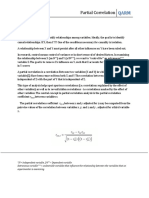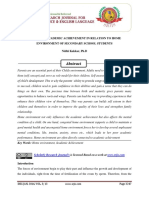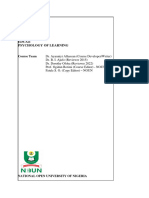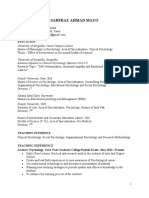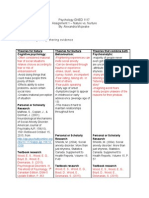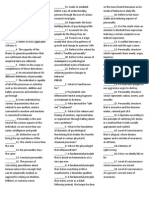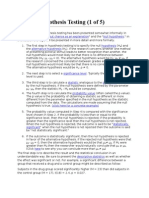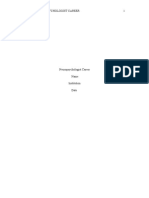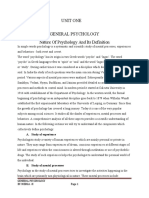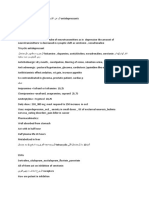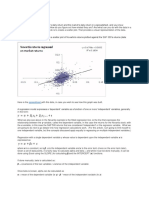0 ratings0% found this document useful (0 votes)
294 views16 pagesInterpreting Regression Output
Uploaded by
JOEL VINCENT PURUGGANANCopyright
© © All Rights Reserved
We take content rights seriously. If you suspect this is your content, claim it here.
Available Formats
Download as PDF or read online on Scribd
0 ratings0% found this document useful (0 votes)
294 views16 pagesInterpreting Regression Output
Uploaded by
JOEL VINCENT PURUGGANANCopyright
© © All Rights Reserved
We take content rights seriously. If you suspect this is your content, claim it here.
Available Formats
Download as PDF or read online on Scribd
You are on page 1/ 16
GraduateTutor.com
Make Learning Easier
Call us: +1 — 732 510 0607
Email: care@graduatetutor.com
Linkedin / Twitter
Interpreting Regression Output (Without all the
Statistics Theory)
Regression analysis is one of multiple data analysis techniques used in business and social sciences. The
regression analysis technique is built on many statistical concepts, including sampling, probability,
correlation, distributions, central limit theorem, confidence intervals, z-scores, t-scores, hypothesis
testing, and more. However, you may not have studied these concepts. And if you did study these
concepts, you may not remember all the statistical concepts underlying regression analysis,
‘The ‘Interpreting Regression Output Without all the Statist
‘heory’ book is for you to read and
interpret regression analysis data without knowing all the underlying statistical concepts.
Who is this book for?
‘This book is primarily written for graduate or undergraduate business or humanities students
interested in understanding and interpreting regression analysis output tables. This book is also helpful
for executives and professionals interested in interpreting and using regression analysis. Itis a
wonderful resource for students or professionals looking for a quick refresher before exams or
interviewing for jobs in the data analysis industry.
This book is not intended to replace a statistics textbook or be a complete regression analysis guide,
Instead, it is intended to be a quick and easy-to-follow summary of the regression analysis output,
‘Interpreting Regression Output Without all the Statistics Theory’ focuses only on bi
insights the
regression output gives you.
This book does not assume that the reader is familiar with statistical concepts underlying regression
analysis. For example, the reader is not expected to know the central limit theorem or hypothesis
testing process. In addition, the reader is NOT expected to be an expert in Microsoft Excel, R, Python,
or any other software that may perform a regression analy
This book is not intended to replace a statistics text book or to be a complete guide to regression
analy:
Interpreting Regression Output Without all the Statistics Theory is based on Senith Mathews’
experience tutoring students and executives in statistics and data analysis over 10 years.
O
5 Chapters on Regression Basics
‘The first chapter of this book shows you what the regression output looks like in different software
tools.
hhe second chapter of Interpreting Regression Output Without all the Statistics Theory helps you get a
high-level overview of the regression model. You will understand how ‘good’ or reliable the model is.
‘The second chapter helps you address the following questions:
= What does the the Multiple R tell me about the relationships between the X and Y variables?
= R-Squared or Multiple R-Squared tell me about the regression model?
= Hows the Adjusted R-Squared different from the R-Squared?
= How is the standard Error useful?
= What does the Significance F tell me about the regression model?
‘The third chapter of Interpreting Regression Output Without all the Statistics Theory discusses the
regression equation and helps you find the ingredients of the regression equation. This chapter helps
you address the following questions:
= What is the regression equation?
= Where can I get the ingredients of the regression equation?
= What does the regression equation tell me?
= What does the intercept indicate?
= What do the coefficients indicate?
= What do the signs of coefficients indicate?
The fourth chapter of this book digs deeper into the regression equation. It helps you interpret the
equation and understand its components. The fourth chapter of Interpreting Regression Output
Without all the Statisties Theory helps you address the following questions:
How do I interpret the Standard Error of the coefficients for each variable in a regression output?
How is the t-statistic or the t-value computed and what does it indicate?
= How can
interpret the P-values in a regression model?
‘What does the 95% Confidence Interval for each variable indicate?
The fifth chapter addresses important points you must keep in mind when using regression analysis. It
includes a brief discussion on some of the following aspects given regression analysis:
= Causation vs Correlation
= Man with a hammer syndrome
= Do outliers impact regression output?
= Underlying Assumptions of regression analysis
Enjoy reading this book. Should you need more assistance with interpreting regression analysis output,
please do not hesitate to call us or send us an email. One of our statistics tutors will be more than happy
to assist you with interpreting your regression analysis output.
Regression Data Used
Quarter TVad Spend Sales
1 a 236
2 Oo 486
3 ta 878
4 6 708
5 0 510
6 0 971
, 36 93
8 38 4177
9 40 9e0)
10 40 962
cn 46 1476
12 45 1359
1a a0 1200
14 0 1280
15 6 1329
16 Ea 1330
Should you need assistance with interpreting regression analysis output, please do not hesitate to call us
or send us an email
O
Chapter 1: Sources & Types of Regression Output
Regression analysis can be performed on a variety of software today. The ubiquitous Microsoft Excel is
still by far the most popular tool. A variety of other free and paid tools are available to run regression
analysis. Some of these include SPSS, SAS, R, Python and JMP, ete.
Each of these tools pi However, all of these
nts the regression analysis output data in different ways
tools provide essentially the same data, We present below the regression output from some of the tools
mentioned above.
Please feel free to play with it live and see the impact it has on the regression equation and the
corresponding chart.
1.1 Microsoft Excel Output
‘SUNEMaRY OUTPUT
Tatole® ‘0307
Sq Data
paused Se 02016
Stands Ever 48.4904
[Sbseratons 6
anova
FS
Reyesor TED TES
Fescuat, ua “soraases 219800
Det 18 1 psope0se
ations Saft Err 1 Stat Press oer Upper 9 ao SSO EE
Tae wares 377 35 Onno aati eka TTL AT
sais yoama 20172 oom zsh 3te 287s
1.2 R Programming Output
can:
Tncformula = sales ~ T.ad.spend, data = data)
nosiduals:
min ag median 3 max
201.88 88.83 “38.03 55.09. 275.60
coefficients
Estimate Std. error t value Prcoit|)
Ganvercept) 437.880 62.348 5.317 0.900109 ~
Viadspend 46.985 2.159 7148 1716-06 ©
Signif. codes: 0 *¥**" oon **** 0,01 #7 0.05 St OL tL
Residual standard error: 148.2 on 14 degrees of Freedom
Nultiple R-equared: 0.8148, Adjustee R-squared: 0. 8016
Fostatistic: 61.59 on 1 and'14 oF, p-value: 1.71e-06
Note that the regression analysis output provides essentially the same information in all these cases,
although it is presented in different formats or designs.
Every number in the regression output indicates something. We will address only the most frequently
used numbers in this book.
Chapter 2: The Big Picture / Understanding the Model
The first set of numbers my eyes wander to are at the top of the regression output in Microsoft Excel
under the heading Regression Statistics.
agression Sta.
Multiple F csr
R Square cea
Adjusted RSg 0.0018
Standerd Ear 148, 1904
Observations 16
This data is presented in the last few rows of the regression output in R. This set of data gives you the
big picture about your regression output, It allows you to answer questions such as:
_ model? What percentage ofthe variation is explained by the variables included?
2.1 The Multiple R
‘The multiple R is the absolute value of the correlation coefficient of the two variables (X and Y) being
evaluated. The correlation coefficient indicates how élosely two variables move in tandem with each
others It assumes that the relationship is linear and so measures the linear relationship between the two
variables X and Y.
‘The correlation coefficient has a value between +1and/=1 A correlation coefficient of #4 indicates that
and in the same direction. A correlation coefficient of o indicates
Seer on i A correlation coefficient of =1 indicates that the
variables move in Seeman eaeoneeatenee
However, since the multiple R is the absolute value of the correlation coefficient, we do not get to know
if the correlation is positive or negative! This means that we do not see the direction of the relationship
and only know the strength of the relationship.
The correlation coefficient is also referred to as the Pearson correlation coefficient or Pearson’s r.
‘The Multiple R in our example indicates a strong correlation between the amount spent on TV ads and
sales. As indicated above, the Multiple R will not tell us ifthe correlation is positive or negative.
2.2 R-Squared or Multiple R-Squared
‘The R+Squared (in Microsoft Excel) or Multiple R-Squared (in R) indicates how well the model or
regression line “fits” the data. It indicates the proportion of variance in the dependent variable (Y)
We know a variable could be impacted by one or more factors. Therefore, the R-Squared indicates the
Pereentage of variation in the dependent variable explained by the independent variables.
In our example, we know that the unit sales of a product will be influenced by various factors such as,
price, competitors’ actions, economy, ete., and not just by the advertisement expenditure. When we run
a regression with sales as the dependent Y variable and only advertisement expenditure as the
independent X variable, the R-square indicates the percentage of variation in unit sales explained by the
advertisement expenditure. It tells you the percentage of change in sales that is caused by varying the
advertisement expenditure. This also means that we can compute the percentage of variation explained
by factors other than advertisement expenditure such as the economy, competition, price, etc. The
percentage of variation that is explained by factors other than advertisement expenditure will be 100%-
Resquare.
Our regression output indicates that 81.48% of the variation in unit sales is explained by the
advertisement budget. And 18.52% (100%-81.48%) of the variation is caused by factors other than
advertisement expenditure.
(Also, note that as the name suggests, the R-square is equal to the square of the multiple R!)
2.3 Adjusted R-Squared —
Adjusted R-Squared is used only when analyzing multiple regression output and ignored when
i . When we have more than one independent variable in our
analysis, the - As the name indicates, the Adjusted R-
Squared is the R-Square adjusted for this inflation when performing multiple regression.
‘The interpretation of the Adjusted R-Squared is similar to the R-square and used only when analyzing
multiple regression output.
2.4 The Standard Error
The standard error in the regression output is a very important number to understand when
interpreting regression data. The standard error is a measure of the precision of the modél. It reflects
the i In other words, if we were using the regression model to
predictor estimate the dependent variable o variable of interest the standarderror shows you how
the standard error reflects
‘how wrong you could be, we want the standard error to be as small as possible.
‘The standard errors used to help You et confidence interval for your predicted values,
2.5 Significance
‘The simplest way to understand the significance F is to think of it as the probability that our regression
‘model is wrong and needs to be discarded!! ‘The significance F gives you the probability that the model
is wrong. We want the
suvmany oureUT
—Regession Sstaies
Taine 3a
RSquare oat
agustck Sa 93015
Stadoré Grr 148 1604
bee 6
Bova
TESS TESS
4 Soraases 2130080
Tot 15 sponse
(Gaaiaon Sanna Ever 1a Pane Conor 5 — Upp To SOTO
Taearent agai Bsa 53 OU ial clea alk
sate some 2a ru omeno “aes aera 2270S
We can see that the Significance F is very small in our example, We usually establish a significance level
and use it as the cutoff point in evaluating the model. Commonly used
“40%: In this example, the Significance F is smaller than any of the commonly used significance levels.
Statistically speaking, the
stance angst In other words it indicates theapmpbabiinyghapellghoenettientatay
i ‘The significance F is computed from the F value (found to the left
of the significance F in Microsoft Excel's output). The F'valte isa valte similar to the Value, tvalue,
ete. It isa ratio computed by dividing the mean regression sum of squares by the mean error sum of
_squiaresi"The F value ranges from 26f0 to a very large number.
Note that the
The key difference is that the
, whereas the P-value!
Chapter 3: The Regression Equation or Model
‘The regression equation or model is the heart of any regression analysis. Since the primary purpose of
this booklet is to teach you how to understand and interpret the regression analysis output, we jump
right into the regression equation or model.
3.1 What is the regression equation?
Remember, in regression analysis; your objective is to figure out the relationship between the variables
being analyzed. One way to express the relationship between the variables is in the form of a
mathematical expression. In simple linear regression, we assume that the relationship is linear or, in
other words, is a straight line, The mathematical expression of a straight line is:
Y=a+bX
In this equation:
= Yis the variable we are trying to predict. Itis called the dependent variable because we are
assuming that Y is dependent on the X variable (the ‘independent’ variable).
= Xis called the independent variable because we assume it is not dependent on Y. Itis also called the
explanatory variable because it is supposed to “explain” what causes changes in Y.
= bis the slope of the regression line. The slope reflects how large or small the change in Y will be for
a unit change in X.
= ais the intercept or the point at which the regression line will intercept the Y-axis.
3-2 Where can I get the ingredients of the regression equation?
‘The values of a and b form the heart of the regression model. ‘The values of a and b are found as the
coefficients in any regression output.
summary oureuT
epee ae —
Tia oa
RSqunre ate
‘AgustecR So 3018
Stand Gnot 143
Deseratons
anova
z 3S cS F__Siaearee
Rogascon Tass (Ise LaF CONDUIT
eaiual 4 “reese 21 e0a0
ot 1 pen 20094
Santo Cor 1S) Pras Cave 0 UperS0R—L SES ape 0S
inept a rr rr Ba RE EIT BTA
sTVais segue 269) rou ome “antsy zeros 2a 2eras
X and Y are variables and will take on different values at different points in time. The values of a and b
are substituted in the regression equation to get the relationship between X and Yas follows:
Y = 437.88 + 16.95*X
This can also be expressed in the context of the example or question making the relationship more
meaningful.
Sales = 437.88 + 16.95*Advertis
ing budget
3.3 What does the regression equation tell me?
What this regression model indicates is that sales are dependent on the advertising budget.
If [spend $1 on advertising, I can expect to have sales of $454.83 (Sales = 437.88 + 16.95*S1)
If T spend $2 on advertising, I can expect to have sales of $471.78 (Sales = 437.88 + 16.95"$2)
If spend $3 on advertising, I can expect to have sales of $488.73 (Sales = 437.88 + 16.95*S3)
3.4 What does the intercept indicate?
The intercept of 437.88 indicates that sales will be 437.88 if we do not spend any money on advertising.
This is because when advertising spend is zero, it (zero) is multiplied by the slope or b (here 16.95),
resulting in a zero. This is added to your intercept, leaving you only the intercept value 437.88.
If I spend $o on advertising, I can expect to have sales of $437.88 (Sales =
137.88 + 16.95"S0)
3.5 What do the coefficients indicate?
‘The coefficient b (here 16.95) indicates that for every unit increase in the X variable (here TV spend),
the ¥ variable (here sales) will change by the amount of the coefficient 16.95. Itis also referred to as the
slope of the line in a simple linear equation.
3-6 What do the signs of coefficients indicate?
the coefficient ofthe independent variable X is positive, it indicates for every unit increase in the
‘nependent ache he epenens nlc ers te leet ie BSN sho
means that for every unit decrease in the independent variable, the dependent variable will decrease by
the value of the coefficient.
On the other hand, ifthe coefficient of the ESOC, for every TTD
Correspondingly, for ae lecrease in the independent variable, the dependent variable will
increase by the value of the coefficient.
In our example, the sign of coefficient b is positive (here, itis +16.95). Therefore for every $1 increase in
TV spend, sales can be expected to increase by $16.95 (the value of the coefficient).
We have only one independent variable in this example. Since you have only one independent variable,
it is called simple linear regression. When you have more than one independent variable, it will be
called multiple regression. Therefore, you will see a coefficient for every independent variable in the
multiple regression output. The interpretation of these coefficients will be the same.
Chapter 4: More on the Regression Equation
In the previous chapter, we understood the regression equation and how good or reliable the regression
is, We also learned how to find the intercept and coefficients of the regression equation.
In this chapter, we will look more deeply into the components of the regression equation.
4.1 Standard Error of the coefficients
The standard error of the coefficients reflects the variability of the coefficient, It reflects the average
error of the regression model. In other words, when we use the regression model to estimate the
coefficient of an independent variable, the
coefficient could be if you use itto make predictions. Again, because the standard error reflects how
wrong you could be, we want the standard error to be small in relation to its coefficient.
‘The standard error is used to help you get a confidence interval for your coefficient values. This is,
discussed further in section _.
We notice that the standard error of our variable 2.16 is small relative to its coefficient of 16.95.
4.2 t-statistic or the t-value
The t value or t statistic is nota number we recommend you focus on. It is computed by dividing the
coefficient by its standard error and is hard to interpret on its own, Ifyou think about a coefficient and
its standard error, you will see that the larger the coefficient is compared to its standard error, the more
reliable it will be. This will indicate that the larger the t value; the more reliable the coefficient.
While the t value is not very helpful by itself, itis needed to compute a handy number ~ the P-value. The
t value is used to look up the Student's t distribution to determine the P-value. The Student's t
distribution shows you how the mean will behave given the size of your sample. The P-value is a really
important and useful number and will be discussed next.
4.3 P-values”
‘The P-value indicates the ili i e best way
to understand the P-value is as the “probability of an error.” We want the P-vallueto be as small as
How small should the P-value be? That depends on a cut-off level that we decide on separately. This
‘The cutoff selected depends on the nature of the data studied
and the different error types. The cutoff or significance level is usually 1%, 5%, or 10%. Generally, a
cutoff point of 5% is used.
Statistically speaking, the P-values the probability of obtaining a result as or more extreme than the
one you got ina random distribution, tn other words, the P-value is the probability that the coefficient
ana ‘The P-value is computed from the t statistic using the Student's t
distribution table.
You will notice that the P-value of the TV spend variable in our example is very small. We do not see a
number after 4 decimals. This indicates that this is a ‘significant variable’ and that the TV spend is likely
to impacts sales figures.
Note that the P-value is similar in interpretation to the significance F discussed earlier in this book. The
key difference is that the P-value applies to each corresponding coefficient, and the significance F
applies to the entire model as a whole.
4.4 The 95% Confidence Interval
‘The coefficient of the independent variable is an estimate of the impact this variable has on the variable
being studied. This is estimated from a sample that was analyzed in our regression analysis. ‘The 95%
confidence interval of your coefficient gives you the range within which the real value of the coefficient
you are estimating falls in. The 95% Confidence Interval is also shown as Lower 95% & Upper 95% in
many packages.
‘You can be 95% confident that the real, underlying value of the coefficient you are estimating falls
somewhere in that 95% confidence interval. So, ifthe interval does not contain 0, your P-value will be
.05 or less.
Rw
‘yswr'sy aacte
Sorenctrer 148s
Bgeeer Tiss TIT wax
posi. Sree 200
Sat iS poles
Tass ania eer 1 Fra Tap
meg as wT Tatar
ina aus pen teeta Carat — sae
‘We can see that the Lower 95% is 12.31 and the Upper 95% is 21.58 in our example. What this indicates
is that while we believe that the coefficient for TV ads in our example is 16.95, there is a 95% chance that
it could be as low as 12.31 or as high as 21.58. Because this range does not include a zero, we have
confidence that the TV ads spend does impact our sales results.
Chapter 5: Things to Remember & Warnings
5.1 Causation vs Correlation
Data analysis using the regression analysis technique only evaluates the relationship between the
variables studied. It does not prove causation. In other words, only the correlation aspect is evaluated,
Causation is defined as the act of causing something, Causation occurs when a change in one variable
causes a change in the other variable. It is also referred to as a causal relationship.
Causation is neither proved nor evaluated in a regression analysis. Instead, controlled studies where
groups are split into two with different treatments are required to prove causation.
5.2 Man with a hammer syndrome
Please remember that regression analysis is only one of the many tools in data analysis. You may fall
into the trap highlighted by the old saying, “To the man with only a hammer, every problem looks like a
nail.” if you know only regression analysis when analyzing data. Regression analysis is appropriate in
many s
‘tuations but not all data analysis situations.
5.3 Sample
Remember that regression analysis relies on sample data and reflects the relationship of the data in the
sample, We assume that the sample reflects the true population, but this need not be so.
5.4 Outliers
Regression analysis is sensitive to outliers. Therefore, the data being analyzed must be scrubbed for
outliers.
5.5 Underlying Assumptions
Regression analysis is built on four underlying assumptions. If these assumptions do not hold, the
regression analysis will not be reliable.
= Linear relationship
= Multivariate normality
= No or little multicollinearity
= No auto-correlation
= Homoscedasticity
Select Resources on Regression
Here are a few resources that will help you learn more about interpreting regression analysis data.
= Regression Primer from PennState
= More in the F test from the Minitab blog
= Another example on interpreting regression output
= Regression hypothesis and the F value in
Note: When you look at the regression output in R, you will see a summary of the residuals. The
interpretation of residuals becomes easy. Bu default, the average of the residuals is zero. The median
should not be far from zero, and the minimum and maximum should be roughly equal in absolute value
in an ideal scenario.
Sign Ur Now
abe@gmail.com
Joe Brown
201.352 5654
Enter a note to your tutor
Get Live Tutoring
More RECENT Posts
‘What is Beta in Finance: Explained by Graduate Tutor
Seven ways to remember the diference between Type 1 and Type 2 errors in hypothesis testing
‘What can actual taxes paid tell you about future eash flows and valuation?
How can valuations with PE ratios of 100x ever be justifies
Does it make sense?
‘What isthe net impact of capitalizing an operating lease have on the Cash Flow Statement?
ConrTACT US
GraduateTutor.com
Forest View Drive
Avenel, NJ 07001
Call us:+1 - (732) 510-0607,
E-mail: care@graduatetutor.com
Privacy, FAQ
Core Areas of Tutoring Sign up Now
Accounting Tutoring
Economics Tutoring
Finance Tutoring
abe@gmail.com
Operations Research Tutoring, ‘em
Statistics for Managers
Joe B
Microsoft Excel Modeling oe Brown,
201 352 5654
Copyright 2007-2021 Enter a note to your tutor
Get Live Tutoring
You might also like
- Chapter 9 Introduction To The T StatisticNo ratings yetChapter 9 Introduction To The T Statistic32 pages
- Stages of Human Development: Prepared byNo ratings yetStages of Human Development: Prepared by21 pages
- A Study of Academic Achievement in Relation To Home Environment of Secondary School StudentsNo ratings yetA Study of Academic Achievement in Relation To Home Environment of Secondary School Students7 pages
- Theories of Counseling and Psychotherapy Systems, Strategies, and Skills by Seligman, LindaReichenberg, Lourie W (Z-Lib - Org) - 288-574No ratings yetTheories of Counseling and Psychotherapy Systems, Strategies, and Skills by Seligman, LindaReichenberg, Lourie W (Z-Lib - Org) - 288-574287 pages
- Statistics Without Maths For Psychology 8th Edition Dancey Instant Download0% (2)Statistics Without Maths For Psychology 8th Edition Dancey Instant Download40 pages
- Assumptions in Psychological Assessment PDFNo ratings yetAssumptions in Psychological Assessment PDF8 pages
- Running Head: Neuropsychologist Career 1No ratings yetRunning Head: Neuropsychologist Career 18 pages
- Mental Retardation: By: Louwella G. Padasas Bsed-English IiNo ratings yetMental Retardation: By: Louwella G. Padasas Bsed-English Ii19 pages
- Schools of Psychology: by Dr. Navin KumarNo ratings yetSchools of Psychology: by Dr. Navin Kumar30 pages
- Unit One General Psychology Nature of Psychology and Its DefinitionNo ratings yetUnit One General Psychology Nature of Psychology and Its Definition36 pages
- The Strengths and Weaknesses of Research MethodologyNo ratings yetThe Strengths and Weaknesses of Research Methodology9 pages
- Short AQAL Beyond The Biopsychosocial ModelNo ratings yetShort AQAL Beyond The Biopsychosocial Model16 pages
- Topic 1 Introdution of Guidance, Counseling & Psychotherapy100% (1)Topic 1 Introdution of Guidance, Counseling & Psychotherapy30 pages
- Educational Psychology: A Scientific ApproachNo ratings yetEducational Psychology: A Scientific Approach13 pages
- Describe and Discuss How Each Psychological Perspective Explains Smoking Using Empirical Evidence25% (4)Describe and Discuss How Each Psychological Perspective Explains Smoking Using Empirical Evidence8 pages
- SPSS Intermediate Understanding Your DataNo ratings yetSPSS Intermediate Understanding Your Data23 pages


